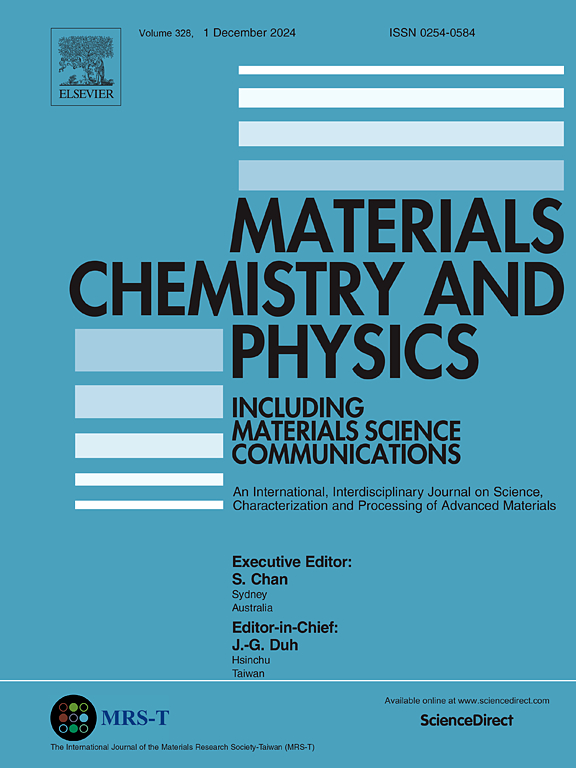Clay-based catalyst for pyrolysis of polypropylene waste into fuels
IF 4.3
3区 材料科学
Q2 MATERIALS SCIENCE, MULTIDISCIPLINARY
引用次数: 0
Abstract
This study utilized montmorillonite clay as an eco-friendly, natural, widely accessible, and cost-effective catalyst in the pyrolysis of polypropylene (PP) waste. XRF analysis revealed the presence of different oxides such as SiO2, Al2O3, CaO, K2O, and Fe2O3. FTIR analysis further confirmed the presence of the oxides. XRD analysis revealed an increase in crystallinity of montmorillonite after calcination, while TGA analysis of calcined montmorillonite revealed lower weight loss compared to the raw sample. The non-catalytic pyrolysis yielded 31.25 % oil, whereas the catalytic process produced 34.45 % oil. Fractionation of the pyrolysis oil yielded different quantities; at 40–100 °C, the non-catalytic process produces 117 mL (23.4 %) of distillate, while the catalysis yields 61 mL (12.2 %), at 140–200 °C, the catalytic process produced 239 mL (47.8 %) and 126 mL (25.2 %) for the non-catalytic process, at 240–280 °C, catalytic process yields 91 mL (18.2 %), nearly double the 62 mL (12.4 %) obtained from the non-catalytic process. The specific gravity was found to range from 0.7922 to 0.8772 and 0.8202 to 0.8722, for non-catalytic and catalytic processes, while API of 47.11 (), 39.16(), were recorded for non-catalytic fractionated oil, against 40.55 (), 41.01(), and 30.73 () for catalyzed enhance oil, and the kinematic viscosity of fractionated oil derived from WPPs falls within the range of 0.57–1.71 cSt and 0.61 to 1.83 cSt for non-catalytic and catalytic processes. As revealed by gas chromatography-mass spectrometry results, hydrocarbons with number of carbons within the range of C5–C12, are the most abundant gasoline fraction, followed by diesel (C13–C24), with fuel oil (>C24). The study has demonstrated the potential of the eco-friendly montmorillonite clay catalyst to enhance the production of valuable fuel products from waste polypropylene. This approach not only addresses critical environmental challenges but also aligns with global efforts to transition towards more sustainable and circular economy.
聚丙烯废热解成燃料的粘土基催化剂
本研究利用蒙脱土作为一种环保、天然、易于获取且经济高效的催化剂,用于聚丙烯(PP)废弃物的热解。XRF分析显示了不同氧化物的存在,如SiO2、Al2O3、CaO、K2O和Fe2O3。红外光谱分析进一步证实了氧化物的存在。XRD分析表明,煅烧后的蒙脱土结晶度增加,而TGA分析表明,煅烧后的蒙脱土比原样品的失重更小。非催化热解产油率为31.25%,催化热解产油率为34.45%。裂解油分馏得到的油量不同;在40-100°C时,非催化过程产生117 mL(23.4%)的馏分,而催化过程产生61 mL(12.2%),在140-200°C时,催化过程产生239 mL(47.8%)和126 mL(25.2%),在240-280°C时,催化过程产生91 mL(18.2%),几乎是非催化过程获得的62 mL(12.4%)的两倍。非催化和催化过程的比重分别为0.7922 ~ 0.8772和0.8202 ~ 0.8722,非催化分馏油的API分别为47.11 (PP100)、39.16(PP200)和29.79(PP280),催化增强油的API分别为40.55 (PPM100)、41.01(PPM200)和30.73 (PPM280), WPPs分馏油的运动粘度分别为0.57 ~ 1.71 cSt和0.61 ~ 1.83 cSt。气相色谱-质谱分析结果显示,汽油馏分中碳数在C5-C12范围内的烃类含量最多,其次是柴油(C13-C24)和燃料油(>C24)。该研究证明了生态友好型蒙脱土催化剂在提高废旧聚丙烯生产有价值燃料产品方面的潜力。这种方法不仅解决了严峻的环境挑战,而且与全球向更可持续和循环经济过渡的努力保持一致。
本文章由计算机程序翻译,如有差异,请以英文原文为准。
求助全文
约1分钟内获得全文
求助全文
来源期刊

Materials Chemistry and Physics
工程技术-材料科学:综合
CiteScore
8.70
自引率
4.30%
发文量
1515
审稿时长
69 days
期刊介绍:
Materials Chemistry and Physics is devoted to short communications, full-length research papers and feature articles on interrelationships among structure, properties, processing and performance of materials. The Editors welcome manuscripts on thin films, surface and interface science, materials degradation and reliability, metallurgy, semiconductors and optoelectronic materials, fine ceramics, magnetics, superconductors, specialty polymers, nano-materials and composite materials.
 求助内容:
求助内容: 应助结果提醒方式:
应助结果提醒方式:


